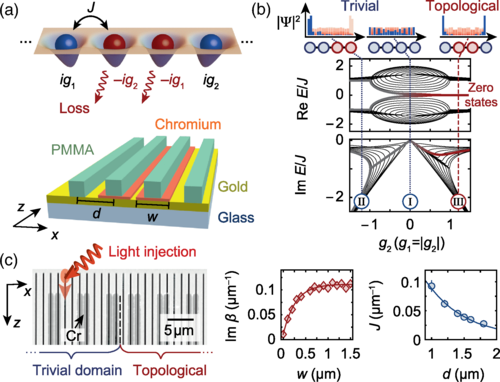Topological states of light and matter in systems with trivial band structures
Topological states of light and matter don’t always require complicated lattice band structures. In their joint work, ML4Q members Julian Schmitt and Stefan Linden were able to reverse this conventional paradigm and induce and control topological edge states by tailoring the contact to an environment! The experimental work on plasmon polariton waveguides demonstrating such states and the advantage of using topology to guide light appeared last week in Physical Review Letters (https://journals.aps.org/prl/abstract/10.1103/PhysRevLett.131.083801).
Abstract: Robust states emerging at the boundary of a system constitute a hallmark for topological band structures. Other than in closed systems, topologically protected states can occur even in systems with a trivial band structure, if exposed to suitably modulated losses. Here, we study the dissipation-induced emergence of a topological band structure in a non-Hermitian one-dimensional lattice system, realized by arrays of plasmonic waveguides with tailored loss. We obtain direct evidence for a topological edge state that resides in the center of the band gap. By tuning dissipation and hopping, the formation and breakdown of an interface state between topologically distinct regions is demonstrated.
Experimental Scheme:

(a) Lattice system with nontrivial topology induced solely by dissipation (top) and experimental realization with DLSPPWs spaced by distance d, where losses are induced by chromium stripes of width w (bottom). (b) Complex-valued energy spectrum for 40 lattice sites with g1=|g2|. For g2<0, the system is topologically trivial and the probability density |Ψ|2 is concentrated in the first two lattice sites (top left). In the topologically nontrivial regime (g2>0), |Ψ|2 is exponentially localized at the edges (top right) and associated with midgap states at zero energy (red lines). (c) Left: Waveguide sample with chromium stripes (dark gray) arranged to realize trivial (topological) domains in the left (right) sample half. The chromium-free region on top is used to excite the waveguides by grating coupling of laser light. Right: Measured dissipation in a single waveguide Imβ versus w and hopping J between two waveguides (as schown in Figure 1 of the publication)
Publication: Observation of a Topological Edge State Stabilized by Dissipation. Helene Wetter, Michael Fleischhauer, Stefan Linden, and Julian Schmitt Phys. Rev. Lett. 131, 083801 – Published 24 August 2023; DOI: https://doi.org/10.1103/PhysRevLett.131.083801